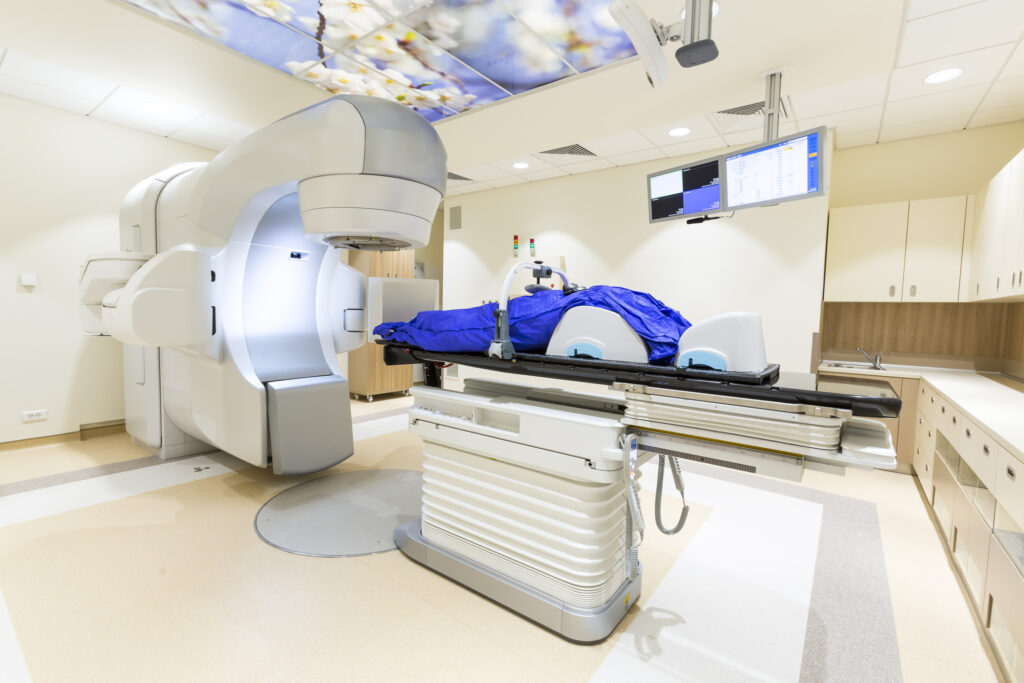Summary: Proton radiation therapy represents a groundbreaking advancement in cancer treatment, offering precision-targeted therapy with minimal damage to surrounding healthy tissues. This article explores the science behind proton therapy, its advantages, applications, challenges, and future potential.
Introduction to Proton Radiation Therapy
Cancer treatment has witnessed remarkable innovations over the years, but few have been as revolutionary as proton radiation therapy. This advanced form of radiation therapy employs protons—positively charged particles of an atom—to precisely target and destroy cancerous cells. By capitalising on the unique physical properties of protons, this therapy minimises collateral damage to healthy tissues, making it particularly suitable for treating tumours in sensitive areas.
The principle behind proton therapy rests on the concept of the Bragg peak, a phenomenon that allows protons to deposit their maximum energy at a precise depth within the body. This unique characteristic distinguishes proton therapy from traditional X-ray radiation therapy and underscores its immense therapeutic potential.
The Physics of Proton Therapy
The Bragg Peak Phenomenon
When protons travel through matter, they lose energy gradually until they reach a specific depth, at which point they deposit the majority of their energy in a sharp burst known as the Bragg peak. Beyond this point, the energy deposition drops to nearly zero. This contrasts with X-rays, which release energy continuously, affecting both the tumour and the surrounding tissues.
The ability to control the depth at which the Bragg peak occurs allows clinicians to deliver high doses of radiation directly to the tumour while sparing adjacent healthy structures.
Particle Acceleration and Beam Delivery
Proton therapy requires sophisticated equipment to accelerate and control protons. Cyclotrons or synchrotrons accelerate protons to nearly two-thirds the speed of light. These high-energy particles are then directed using magnets to form a beam that can be precisely focused on the tumour.
Modern proton therapy centres utilise advanced imaging technologies and computerised planning systems to ensure the beam accurately targets the tumour’s location, accounting for patient movement and anatomical changes during treatment.
Clinical Advantages of Proton Therapy
Precision Targeting
One of the primary benefits of proton therapy is its unparalleled precision. This makes it especially valuable for treating tumours located near critical structures such as the brain, spinal cord, or eyes. For instance, proton therapy is widely used for paediatric cancers, where sparing healthy tissues is vital for growth and development.
Reduced Side Effects
Traditional radiation therapy often leads to side effects caused by damage to surrounding healthy tissues. Proton therapy significantly reduces these effects by concentrating the radiation dose on the tumour. Patients undergoing proton therapy generally experience fewer complications and a better quality of life during and after treatment.
Improved Outcomes in Certain Cancers
Proton therapy has demonstrated superior outcomes in treating certain types of cancers, including:
- Paediatric tumours: Reducing radiation exposure minimises the risk of developmental delays and secondary cancers in children.
- Head and neck cancers: The therapy preserves vital structures, reducing the risk of complications such as vision or hearing loss.
- Prostate cancer: Precision targeting reduces side effects like incontinence and erectile dysfunction.
- Brain tumours: It is highly effective for treating gliomas and other tumours located near critical brain areas.
Applications of Proton Therapy
Paediatric Oncology
Children are particularly vulnerable to the long-term effects of radiation therapy. Proton therapy’s precision minimises the impact on growing tissues, making it the preferred option for paediatric brain tumours, sarcomas, and other malignancies.
Recurrent Tumours
When cancer recurs in previously irradiated areas, retreatment using conventional radiation is often limited due to the risk of exceeding the tolerance dose for healthy tissues. Proton therapy provides a safer alternative for such cases.
Treatment of Rare and Complex Tumours
Proton therapy is highly effective for rare and complex tumours, such as chordomas and chondrosarcomas, which occur near the spinal cord or brainstem. These tumours require precision to avoid debilitating side effects.
Challenges and Limitations
High Costs
Building and maintaining proton therapy facilities requires significant investment. A single proton therapy centre costs upwards of £100 million, primarily due to the complexity of the equipment. This financial barrier limits the availability of proton therapy, particularly in low-income regions.
Limited Accessibility
There are relatively few proton therapy centres worldwide compared to traditional radiotherapy facilities. Patients often need to travel long distances for treatment, which can be burdensome, especially for those undergoing extended therapy schedules.
Treatment Suitability
Proton therapy is not universally suitable for all cancer patients. It is most beneficial for localised tumours that have not metastasised, as systemic cancers typically require chemotherapy or other forms of treatment.
Technological Innovations in Proton Therapy
Pencil Beam Scanning
Pencil beam scanning (PBS) is an advanced delivery technique that uses a narrow, focused proton beam to “paint” the tumour layer by layer. This approach offers even greater precision and allows for the treatment of complex tumour shapes while sparing adjacent tissues.
Image-Guided Proton Therapy (IGPT)
Advances in imaging technologies, such as MRI and CT integration, have improved the accuracy of proton therapy. IGPT ensures that the proton beam remains precisely aligned with the tumour, even if the patient moves or if the tumour shifts slightly during treatment.
Adaptive Proton Therapy
Adaptive therapy uses real-time imaging and data to adjust treatment plans based on changes in the patient’s anatomy over the course of therapy. This innovation enhances the efficacy and safety of proton therapy.
Future Prospects of Proton Therapy
Expansion of Proton Therapy Centres
As technology advances and costs decrease, more proton therapy centres are being established worldwide. These efforts aim to make proton therapy more accessible and affordable, enabling a broader patient population to benefit from this cutting-edge treatment.
Integration with Other Therapies
Proton therapy is increasingly being combined with other treatment modalities, such as immunotherapy and targeted therapies. This integrative approach aims to maximise tumour control while minimising side effects.
Advances in Compact Proton Systems
Researchers are developing smaller, more cost-effective proton therapy systems. These compact systems could be installed in existing hospitals, expanding access to proton therapy and reducing treatment costs.
Ethical Considerations and Equity
The high cost and limited availability of proton therapy raise important ethical questions. Who should have access to this advanced treatment, and how can we ensure equitable distribution of resources? Addressing these challenges requires collaboration between governments, healthcare providers, and manufacturers to balance innovation with affordability.
Case Studies: Success Stories in Proton Therapy
Paediatric Medulloblastoma
A seven-year-old patient diagnosed with medulloblastoma, a type of brain tumour, underwent proton therapy. The precision of the treatment spared the surrounding brain tissue, reducing the risk of cognitive decline. Five years later, the patient remains cancer-free with no significant long-term side effects.
Prostate Cancer in Older Adults
A 65-year-old patient received proton therapy for localised prostate cancer. The targeted approach resulted in minimal urinary and sexual side effects, allowing the patient to maintain a high quality of life post-treatment.
Head and Neck Tumour Near the Optic Nerve
A patient with a tumour located dangerously close to the optic nerve underwent proton therapy. The treatment successfully eradicated the tumour while preserving the patient’s vision, a feat that would have been challenging with traditional radiation therapy.
Conclusion
Proton radiation therapy stands at the forefront of modern oncology, combining advanced physics, medical expertise, and technological innovation to provide precise and effective cancer treatment. While challenges such as high costs and limited accessibility persist, ongoing research and development promise to make this life-saving technology more widely available.
As proton therapy continues to evolve, it offers hope for improved cancer outcomes, fewer side effects, and a brighter future for patients worldwide. By embracing this groundbreaking therapy, we are taking a significant step towards more personalised and effective cancer care.
Disclaimer
The content provided in this article, “The Fascinating World of Proton Radiation Therapy,” is intended for informational and educational purposes only. It does not constitute medical advice, diagnosis, or treatment and should not be relied upon as a substitute for consultation with qualified healthcare professionals.
While every effort has been made to ensure the accuracy and relevance of the information at the time of publication, Open Medscience makes no representations or warranties of any kind, express or implied, about the completeness, accuracy, reliability, or suitability of the information contained herein. Proton radiation therapy is a highly specialised treatment and may not be appropriate for all patients. Decisions regarding medical care should always be made in consultation with a licensed medical practitioner familiar with the patient’s individual condition and medical history.
Mention of specific technologies, clinical practices, institutions, or treatment outcomes is for illustrative purposes only and does not imply endorsement or guarantee of effectiveness. Any case studies or examples are presented for general context and may not be representative of typical results.
Open Medscience assumes no liability for any direct, indirect, incidental, or consequential loss or damage arising from the use or interpretation of this article.
For personalised medical advice or information about treatment options, please consult a qualified healthcare provider.
You are here: home » diagnostic medical imaging blog »



